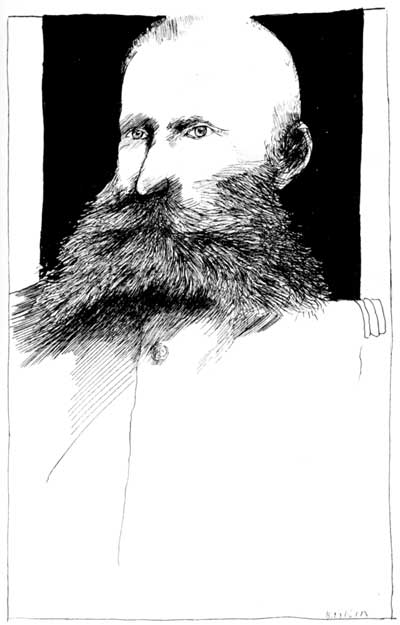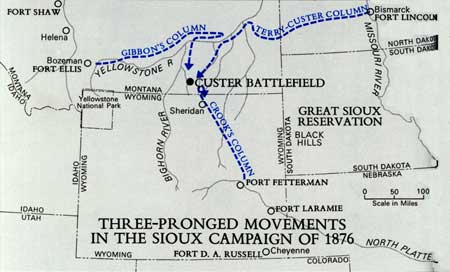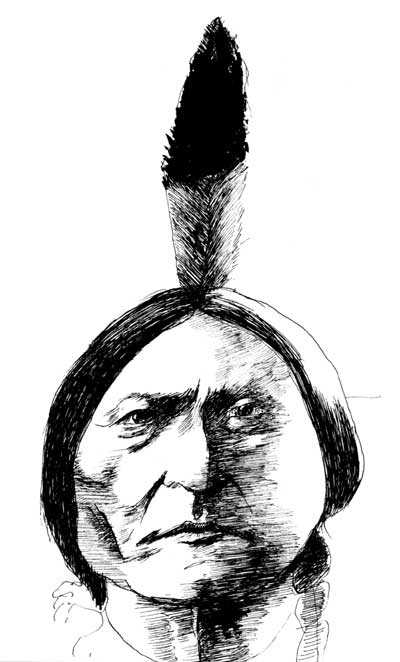|
LITTLE BIGHORN BATTLEFIELD National Monument |
 |

Brig. Gen. George Crook.
Campaign of 1876
In Chicago Lt. Gen. Philip H. Sheridan, whose Division of the Missouri included the Sioux country, welcomed this decision. He had advocated a winter campaign that would catch the Sioux off guard and had fretted over the delay caused by the Indian Bureau's insistence on first giving them a chance to come in. At once Sheridan ordered his department commanders, Brig. Gen. George Crook in Omaha and Brig. Gen. Alfred H. Terry in St. Paul, to organize strong expeditions for an invasion of the enemy stronghold. The plan was for three columns, one from Crook's department and two from Terry's department, to converge from three directions on the locale thought to be occupied by the Indians. No particular concert of action was planned, for each column would be strong enough to defeat the 500 to 800 warriors the Indian Bureau estimated to be absent from the agencies.
Bad weather delayed General Terry's two columns, but General Crook, the "Gray Fox," at once organized an 800-man column, consisting of infantry and cavalry, at Fort Fetterman, Wyo. During early March he pushed northward on the old Bozeman Trail through deep snow and subzero cold. On March 17 a striking column of six cavalry companies, led by Col. J. J. Reynolds, assaulted a winter camp of Sioux and Cheyennes on Powder River. The surprised Indians scattered but mounted a counterattack that prompted the cautious Reynolds to abandon his gains and fall back on the main column. Crook turned about and headed for Fort Fetterman to outfit for another campaign.
As Crook reorganized at Fort Fetterman, Terry prepared his two commands, and in April and May 1876 Sheridan's three-pronged offensive, now a summer instead of a winter operation, at last got underway. Early in April Col. John Gibbon led the "Montana Column"—about 450 men of the 2d Cavalry and 7th Infantry Regiments—eastward from Fort Ellis, Mont., down the north bank of the Yellowstone River. On May 29 Crook's expedition again headed north from Fort Fetterman. And on May 17 the "Dakota Column" marched out of Fort Abraham Lincoln and, leaving the Missouri River behind, pointed toward the Yellowstone.
The Dakota Column included all 12 companies of the 7th Cavalry Regiment, two companies of the 17th Infantry and one of the 6th to guard a train of 150 wagons, a detachment of the 20th Infantry serving three rapid-fire Gatling guns, and about 40 Arikara Indian scouts. Altogether the Dakota Column numbered about 925 officers and men. Although General Terry accompanied it, he expected the colorful commander of the 7th Cavalry to lead his horsemen in the swift thrust that would bring the enemy to battle. This was Lt. Col. George Armstrong Custer, a major general in the Civil War and now, at 36, a plainsman of 10 years experience. Custer and his regiment had fought Sitting Bull on the Yellowstone in 1873 and confirmed the existence of gold in the Black Hills in 1874. Now, as Terry's striking arm, they hoped for an opportunity to crush the power of the Sioux for all time.

Three-Pronged Movements in the Sioux Campaign of 1876.
(click on image for an enlargement in a new window)
Terry received no indication of the probable location of the hostiles until he reached the Yellowstone. At the mouth of the Powder River, he met officers from the Montana Column who reported that Colonel Gibbon's scouts had discovered an enemy camp in the valley of the Tongue River. Sending Maj. Marcus A. Reno and six companies of the 7th Cavalry on a southward swing to examine this valley further, Terry prepared to push on to meet the Montana Column.
At the mouth of the Powder, the general established a supply depot manned by his infantry and another three companies that had marched south from Fort Buford. Here, too, he met Capt. Grant Marsh with the river steamer Far West, chartered by the Government to transport supplies and speed communication. Leaving all his wagons at the depot and organizing a mule packtrain to carry provisions, Terry sent Custer up the river bank and himself boarded the Far West, to steam to the mouth of Rosebud Creek, where Gibbon's troops lay in camp on the north side of the Yellowstone.
Custer and Reno reunited here on June 21. Reno had led his scouting force into the Rosebud Valley and discovered an Indian trail that confirmed Terry's suspicions: the hostiles were moving up this valley and would probably cross the Wolf Mountains into the valley of a stream that the Sioux called the Greasy Grass but that Army maps labeled the Little Bighorn.

Chief Sitting Bull.

|
|
Last Modified: Sat, Sep 28 2002 10:00:00 pm PDT |


